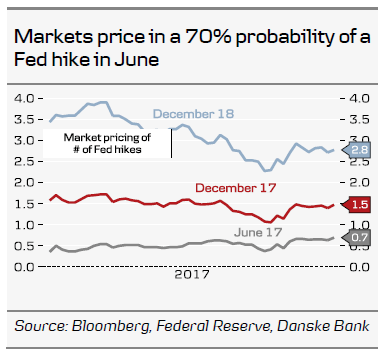As expected, the Fed’s May meeting was quite dull in the sense that we did not get any new information. The fed funds target range was maintained at 0.75%-1.00% and since it was one of the small meetings without updated projections or a press conference, we only got the meeting statement, which was more or less unchanged from the last meeting in March (also as expected). Most interesting is that the Fed thinks the weak GDP growth of 0.7% q/q AR in Q1 was ‘likely to be transitory’. The Fed still expects growth to continue at a moderate pace leading to further labour market tightening and inflation to stabilise around 2%. Near-term risks to the economic outlook still appear ‘roughly balanced’. It will be more interesting to listen to the upcoming Fed speeches for their views.
While consensus is that the Fed will hike at the June meeting, we are more sceptical, because of the weaker economic data as well as still too low inflation in the US and the Fed’s desire to begin reducing the balance sheet soon, which we call ‘quantitative tightening’ (QT). We think the Fed wants to send up a trial balloon in June by announcing what conditions would trigger a change in its current reinvestment strategy in order to avoid a new round of ‘taper tantrum’. We have written extensively about the QT theme this year: Fed’s Quantitative Tightening: Fixed Income Implications, 6 April, FOMC Minutes: Quantitative tightening is moving closer, 5 April and Research US: Fed’s regulatory hurdle for starting quantitative tightening, 13 March. We think actual quantitative tightening will start in Q1 18.
We expect the Fed to hike in July and December and three to four times next year (although the outlook, especially for next year, has become more uncertain, as it depends both on the Fed’s strategy on quantitative tightening and Trump’s ability to deliver on Trumponomics). Markets price in 1.4 more hikes this year and 2.8 more hikes by year-end 2018. Markets price in a 70% probability of a Fed hike in June.
EUR/USD edged slightly lower and below the 1.09 level on the somewhat dull FOMC statement, which notably did not include any new hints on ‘quantitative tightening’. Thus the Fed has yet to test FX market sensitivity to this issue for real. Indeed, the combination of the Fed shrinking its balance sheet and hiking will be a challenge communication-wise, insofar as the Fed wishes to avoid swift tightening of financial conditions including a stronger USD. For EUR/USD, focus in the coming months will be on both Fed and the ECB adopting slightly less accommodative stances, i.e. Fed addressing its reinvestment policy and delivering another hike while, at the same time, the ECB is likely to amend its introductory statement to signal that rates will not go lower from here. We still look for the cross to stick – by and large – to the 1.06-1.10 range in 1-3M. Near term, the next focal point for USD crosses will be Friday’s job report where we see a risk of somewhat downbeat readings on both payrolls and earnings; should this hold true, it could – coupled with a muted relief rally in the cross on a Macron win – lead EUR/USD to test the 1.10 level, however.


















